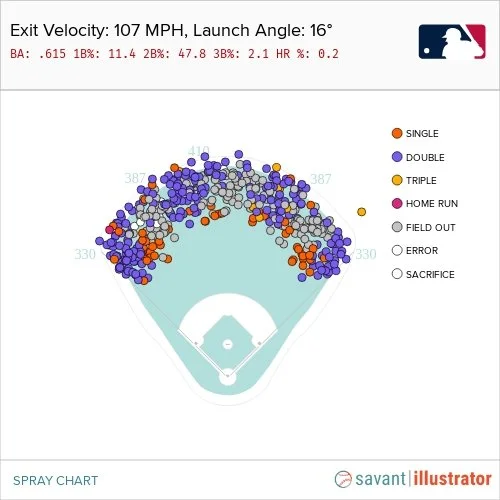So, Is Tennis Now Up To Speed?
It was only a matter of time before the ATP finally left the Bronze Age. Here’s how they did it.
Andre Agassi. Notorious tennis player and autobiographer (his book is a brilliant read, if you have the time)
I recently wrapped up my role at Sports Info Solutions, a company that collects data and metrics for professional and collegiate sports teams to help them better understand the events that occur in the field of play. My job was to watch baseball all day and, on a specialized software package, record everything that happened during every single pitch of the game. It was a unique and rewarding opportunity, and it was my first experience working in the sports world. There are a handful of companies out there who do a similar kind of work for both sport organizations and the general public, such as Pro Football Focus and Fangraphs, all with the goal in mind of digging beneath the surface and uncovering statistical anomalies and advantages within the recorded data.
I am a fan of sports. I love watching a baseball, football, basketball, soccer (I call it football too), or hockey game on the TV. I’ll watch the final round of a golf tournament. I am prone to watching tennis all day if I am free. In fact, tennis has been the go-to for me recently. I have gotten so invested in the sport that I even started taking lessons. It feels better to watch something and know what players are trying to do, right?
Qualifying matches at the 2024 US Open. Usually a good watch before the main draw opens up.
As my interest went deeper and deeper into the sport, I was curious as to whether there were companies or organizations that track data for tennis players to utilize in order to gain a competitive advantage, similar to what I did during my time at Sports Info Solutions. Does he hit a slice serve on his 2nd serve? When is he likely to go up the line? How many baseline forehands before he wants to come to the net? These were all questions that I thought tennis players would love to know the answer to.
Sports have witnessed a profound transformation through the integration of analytics. They have fundamentally altered how performance is assessed and how strategies are developed. Baseball was the pioneer of integrating statistical analysis with roster construction and player evaluation. We have now seen its implementation in basketball (I still hate you, Daryl Morey. I haven’t forgiven you for how you left the Rockets in shambles) and in hockey (it’s early but it’s promising, look up @JFreshHockey on Twitter. Good stuff going on there). My overarching question is if the current sports analytical model possesses a reliable framework for its adaptation to tennis and if it has been used to help players gain an edge over their opponents.
The Foundation of Baseball Analytics
A spray chart displaying every batted ball at the listed exit velocity and launch angle since 2015 in all of MLB. Baseball Savant is an online resource that uses Statcast technology to create visualizers, charts, graphs, and more for evaluation and comparison of every MLB player since 2015.
Analytics in baseball gained widespread prominence in the late 20th century, primarily through the work of Bill James (his Historical Baseball Abstracts) and organizations like the Oakland (RIP) Athletics and Cleveland Indians (RIP…well…maybe not in peace, that logo was a disgrace). The advent of Sabermetrics, a term coined by Bill James, introduced advanced metrics that surpassed traditional statistics, offering deeper insights into player performance and game strategy. Metrics such Weighted Runs Created plus (wRC+), Wins Above Replacement (WAR), and Defensive Runs Saved (DRS) became essential tools for MLB front offices, enabling data-driven decision-making, the reshaping of rosters, a reevaluation of long used in-game strategies, and player valuation in free agency, the amateur (officially called the Rule 4) draft and salary arbitration. Nowadays, most (successful) MLB clubs employ dozens of data scientists and analysts to sift through data points and create predictive models that influence almost all aspects of the baseball operations department, from scouting to player development and coaching.
Translating Baseball Insights to Tennis
So, how do we translate the analytic bible of baseball into the language of tennis? At the core of baseball analytics is the established pantheon of multifaceted performance metrics. These are the things you’ll find on a random bench player’s Baseball Reference page if you scroll down a little bit (Jason Bourgeois, I’m thinking of you today. I hope you’re loving Chicago). Things like OPS+, wOBA (rOBA if you’re using Baseball Reference’s model) and Rbat+ are all performance metrics that try to get a player’s statistical contributions down to a single number, usually normalized to where the “league average” is the number 100 (105 would be 5 percentage points better than the average player in the league, 95 would be 5 points worse than average). Tennis has already benefited from the establishment of comprehensive (ehhh…let’s say slightly comprehensive) metrics that try to encapsulate a player’s effectiveness. Traditional statistics, such as aces and unforced errors, are supplemented by advanced metrics like Serve Efficiency, Break Point Conversion Rate, and Return on Serve. These metrics provide a slightly more nuanced understanding of a player's overall performance on the court.
A clipping from Jason Bourgeois' Baseball Reference Page, showing some of his sabermetrics during his career. Note that there are no Exit Velocity or Hard Hit% numbers before 2015, due to Statcast not existing until that year.
The problem with performance metrics is that they don’t really give you an idea of what a player is going to do but rather how good (or bad) a player is on a regular basis. They are not predictive. Performance metrics only tell you the results of a player across the board (occasionally, the FIP metric in baseball is a called an “ERA predictor” but those metrics are still only affected on a season-to-season basis). It lacks the ability to determine what adjustments a player needs to make in preparation of their opponent. That’s where strategic optimization comes into play. In baseball, the harnessing of data has revolutionized decision-making, particularly in areas like pitch selection and defensive positioning. This has tried to be replicated in tennis by analyzing match data to influence future shot selection, court positioning, and on-the-fly tactical adjustments. If tennis were to make it easier to leverage historical data on opponents before and after matches, players would be able to refine their specific strategies and optimize their chances of getting the upper hand in a dynamic, high-pressure situation.
It is now standard in all MLB and Triple-A ballparks to have Hawk-Eye camera tracking systems in place for data collection
The technological advancements that have propelled baseball analytics forward—such as TrackMan and Statcast—have brought data analytics to a different stratosphere. Every infinitesimal detail of each pitch thrown and each swing of the bat is meticulously studied and analyzed. The spin, spin axis, spin efficiency, velocity, exit velocity, launch angle, bat speed and more are all recorded at the Major League and Triple-A levels, giving organizations enormous data sets to work with. This allows teams to chart and track every pitch from every pitcher in their organization and create in-depth biometric player development systems. This also affects the in-game strategy aspect for teams and plays a big role in roster construction (many teams love having a multitude of pitchers who can spin the ball exceptionally well; look at Tampa Bay’s track record of developing spin demons for reference). In tennis, innovations like Hawk-Eye and player tracking systems provide plenty of data points that can be utilized for performance purposes and strategic refinement. Forehand top spin, serve velocity and spin, and even shot quality is now recorded (with mind-numbingly complex algorithms, you can apparently do that now).
Culture Shock, Of The Sporting Kind
Historically, most of the data in tennis (both biometric and statistical) was collected by a tournament’s 3rd party tech company or broadcast network and was provided largely for broadcast purposes (if it was even collected at all). The nature of tennis is characterized by its lack of standard play intervals (baseball is quite literally one pitch at a time where tennis is a bit freer flowing). The unpredictable dynamics of tennis matches complicates data collection and analysis, when compared to a relatively static set up in an MLB game. Mainly, the biggest difference is the structure of each sport. Baseball teams are organizations. They cut checks to players and those players put on the jerseys that don the team’s name. Tennis players don’t play for the ATP or the WTA. They simply play in tournaments organized by the ATP and the WTA. They play in tournaments to make money so they can continue to play in tournaments. They are individuals who are usually surrounded by a coach, a trainer, and maybe a manager/psychologist. On the court, they’re by themselves. Coaches are not allowed to coach during a match from the player’s box (mostly). There was no real-time data collection or evaluation. Every strategic decision was made before the match with their team or by the player during the match on their own.
Milos Raonic in the process of uncorking a 150 MPH serve (according to radar guns around the world)
This is where I think we get the disconnect between analytics in team sports like baseball and in “individual” sports such as tennis. These baseball (basketball and football, too) teams have entire DIVISIONS of their organization dedicated to data collection and analysis for their own team. They have resources (quite literally tens of millions of dollars) allocated for all sorts of predictive and inefficiency modeling. Tennis is so far removed from that realm of sports. It’s so individual. Only since 2019 has there been an existence of a “player’s union”. It was difficult and expensive to find someone to track data for you (if a tournament would somehow allow that to happen with their privacy policies) and analyze it in a way that a player could digest and implement into their strategy and preparation. It was simply not a viable option for most players on the ATP and WTA tour.
Tennis Finally Figured Out What To Do With Jeremy Renner
Now here is the fun part (I guess it’s fun). In September of 2023, the ATP delivered a press release stating that it was launching a new analytics tool called Tennis IQ available to all players and coaches on the ATP Tour. It was developed by a sports data company called TennisViz in conjunction with former players and coaches. And man, it might be the coolest effin’ thing in the world of sports data (yes, even cooler than you Baseball Savant). Real-time shot tracking! And shot quality! And attacking vs. neutral vs. defending phase monitoring! And even crazier shit that I can’t comprehend. Basically, it provides players and coaches every single metric from any player during any match at any tournament, from an ATP 250 to a Masters 1000 event. It allows players to see how well their forehand stacks up against the rest of the field, displaying spin, depth, and speed on each shot. It allows you to see where on the court your opponent liked to hang around during his last match. It lets you see the quality (metrically, at least) of your upcoming opponent’s backhand slice during his past two matches of the tournament. And it's paired with video! It’s able to show tendencies and strengths and weaknesses and patterns. Quite the feat, if I must say.
An image from the original press release, giving a tiny look at the new platform for players and coaches
I think this is the beginning of a serious relationship between tennis and analytics that people (players and fans, mostly) have been longing for. Tennis had Hawk-Eye technology (since 2006!!!) long before it became standard in MLB ballparks. The baseball world figured out quickly how to use Hawk-Eye to help players and teams succeed in their development and scouting. And the only thing the tennis world had used it for was to fix incorrect line calls made by geriatric chair umpires? What the hell was that about? I’m glad that the data revolution (I’m not sure you can even call it that anymore) has finally found its place in professional tennis. And I hope it kicks its feet up and makes itself comfortable. Good on the ATP for getting it done and I’m excited to see where it will take the sport as a whole. I guess the engine has finally turned over and maybe (just maybe) tennis is up to speed on the analytic freeway.
Check out baseball-reference.com for more information on the statistics listed in BOLD






